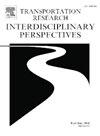Behavioral consistency between real and simulated driving: a multi-layered experimental study
IF 3.8
Q2 TRANSPORTATION
Transportation Research Interdisciplinary Perspectives
Pub Date : 2025-07-01
DOI:10.1016/j.trip.2025.101512
引用次数: 0
Abstract
This study investigated behavioral consistency of across the operations of braking, accelerating, and steering between a real vehicle and a driving simulator (DS). Behavioral consistency between the real vehicle and the DS was examined based on two criteria. The upper criterion was derived from the constraint that even if the fidelity of the DS increases, it cannot exceed the behavioral consistency when driving in a real vehicle. The lower criterion was derived from the constraint that the physical course on which the vehicle is traveling produces a minimum level of consistency. Experiments were conducted on isomorphic courses to compare driving behavior across a real vehicle, a DS, and a dot vehicle (a sprite in a driving game). The behavioral consistency of each driving operation (braking, accelerating, and steering) was calculated as a Pearson product-moment correlation coefficient using the amount of operation along the course for each system. The results showed a high consistency in steering between the real vehicle and the DS. However, braking and accelerating showed lower consistency. It was suggested that the discrepancies in braking could be attributed to inherent human characteristics in real-world driving, while the issues with acceleration could be associated with the DS’s fidelity.
真实驾驶与模拟驾驶的行为一致性:一项多层实验研究
本研究调查了真实车辆和驾驶模拟器(DS)之间制动、加速和转向操作的行为一致性。基于两个标准检验了真实车辆与自动驾驶系统之间的行为一致性。上限准则是根据虚拟驾驶系统的保真度即使提高,也不能超过真实车辆行驶时的行为一致性约束而得出的。较低的标准是从车辆行驶的物理路线产生最小一致性的约束中得出的。我们在同构路线上进行了实验,以比较真实车辆、DS和虚拟车辆(驾驶游戏中的精灵)的驾驶行为。每个驾驶操作(制动、加速和转向)的行为一致性使用每个系统沿路线的操作量计算为皮尔逊积矩相关系数。结果表明,实际车辆与自动驾驶系统之间的转向具有较高的一致性。然而,制动和加速的一致性较低。有人认为,刹车的差异可能归因于现实驾驶中固有的人类特征,而加速问题可能与DS的保真度有关。
本文章由计算机程序翻译,如有差异,请以英文原文为准。
求助全文
约1分钟内获得全文
求助全文
来源期刊

Transportation Research Interdisciplinary Perspectives
Engineering-Automotive Engineering
CiteScore
12.90
自引率
0.00%
发文量
185
审稿时长
22 weeks
 求助内容:
求助内容: 应助结果提醒方式:
应助结果提醒方式:


